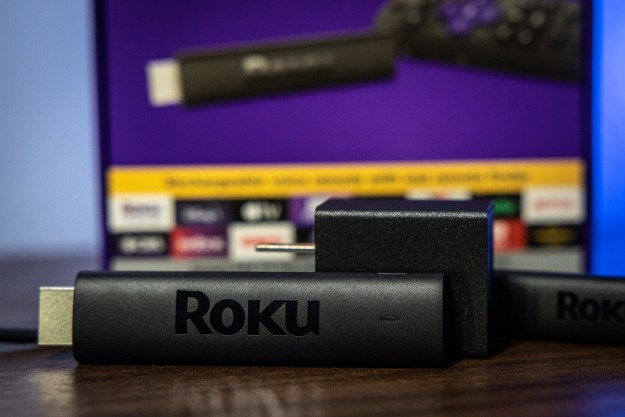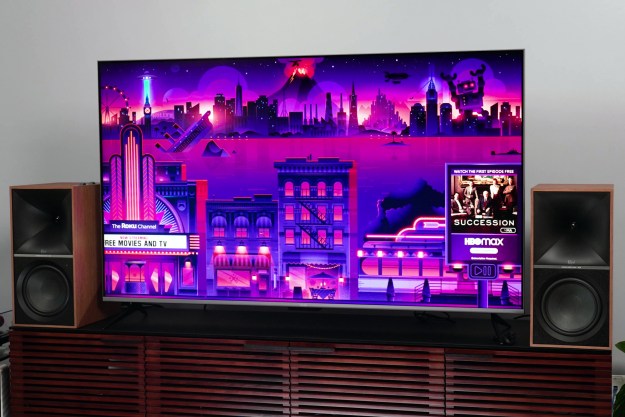
“Roku's Plus Series is an undeniable value, but leaves room for improvement.”
- High brightness
- Brilliant color
- Snappy operation
- Impressive sound
- Great remote
- Poor off-angle performance
- Contrast suffers in high-brightness scenes
- Some motion blur
The first Roku TVs are here. That is, the first TVs built by Roku are now available for purchase. I’ve written about why I think Roku making TVs is important. Now it’s time to find out if its TVs are any good. In this review, we’ll be taking a look at the premium tier of Roku’s new TV lineup, the Roku Plus Series.
I received a 65-inch Roku Plus Series model for review, but the Plus Series also features 55- and 75-inch options, and all are currently available exclusively at Best Buy. The prices for the TVs appear to already be in flux. Retail price for the Plus Series is set at $650, $800, and $1,200 for the 55-, 65-, and 75-inch models, respectively, but sales prices already have them at $500, $650, and $1,000. For this review, I take the sale prices into account, as I believe those sale prices will soon be the norm.
Video review
Out of the box
Unboxing this TV was pretty straightforward. The legs require three screws each and have strong TCL and Hisense TV vibes. The back of this TV is very interesting because, unlike many TV brands, rather than spread the electronics out over as many square inches as possible for the shallowest depth possible, Roku seems to bunch it up in a smaller, but slightly more protruded area. Aside from increasing the total mounting depth of this TV, that also pushes the input bay well toward the center of the TV. It’s hard to know if this will be problematic for anyone, but I’m imagining myself trying to connect an HDMI cable after the TV is already wall-mounted and am thinking that could be a little bit of a pain.
The TV comes with the Roku Voice Remote Pro, which is rechargeable via USB and has a switch that enables or disables hands-free voice commands for the built-in mic. It also has a headphone jack for private listening, though you can also use Roku’s app for that task. It also has two assignable buttons, labeled “1” and “2,” in addition to the hotkeys for Netflix, Disney+, HBO Max, and Apple TV+, which is presently the most sensible assembly of apps I’ve seen on a remote yet.
While it wasn’t exactly lightning-fast, the TV did take significantly less time to update and set up than even other very recent Roku TV setup experiences I’ve had. I was already logged into many of my apps — except Netflix, which is probably Netflix’s fault.
Also, the operation of this TV is probably the fastest Roku experience I’ve ever had. I still think the
The TV itself looks smart enough — three virtually borderless bezels, along with a wide metallic strip on the bottom. Pretty standard fare these days.
Series and size details
While we reviewed the 65-inch 65R6A5R model, our review also applies to the 55-inch and 75-inch models in the Roku Plus Series.
| Screen Size | Model Number | MSRP |
| 55-inch | 55R6A5R | $649.99 |
| 65-inch | 65R6A5R | $799.99 |
| 75-inch | 75R6A5R | $999.99 |
Performance
The TV doesn’t support 4K at 120Hz, but it does support HDR, HDR10+, and Dolby Vision. You can also seamlessly integrate any of Roku’s soundbars, speakers, or subwoofers, along with any of Roku’s smart home devices, of which there is a rapidly growing catalog.
I’m about to dive into some deeper measurement data next. If you’d rather skip some of this geekier stuff and get to the takeaway, please feel free to scroll to the next section.
Brightness
Now we come to the ever-important discussion of brightness. I used the Movie mode for SDR and HDR, and I used a customized version of Dolby Vision to measure the TV’s peak brightness and color accuracy, as well as color gamut. I disabled most extraneous processing, but one setting that is absolutely going to be crucial to this discussion is the local dimming setting. You can choose Off, Low, Medium, and High — and I can tell you now that you should never have this setting turned off, and that the Low setting wasn’t ever useful to me. But if you get this TV, you have some decisions to make about whether to use Medium or High. I’ll explain more as we go forward.

You can also choose a rather broad TV brightness option, Auto, which adjusts based on the ambient room lighting and is a setting I never use, or Darker, Dark, Normal, Bright, and Brighter. This is a common Roku picture setting that helps folks who may never get into some of the more specific picture settings to get a picture that is suitably bright for their viewing environment. In order to get at the TV’s peak luminance, I chose Brighter for most of my measurements.
To measure, I used Calman Ultimate calibration software along with a SpectraCal C6 colorimeter profiled to an X-rite i1 Pro 2 spectrophotometer.
Here’s the data: In SDR, the TV put out 580 nits from a 10% white window. In HDR modes, the results were varied. In a peak luminance test that runs through various window sizes, the peak brightness topped out at 825 nits – now, this was with local dimming set to high. In a peak luminance stability test, in which I used a 10% window (which has been standard practice for a long time) it was stable at 700 nits. That threw me for a second, but when I went back to the first test, I noticed the TV was brightest when it was putting up a bigger, 25% window. So I ran the second test with a bigger window and, sure enough, it boosted into the low 800s.
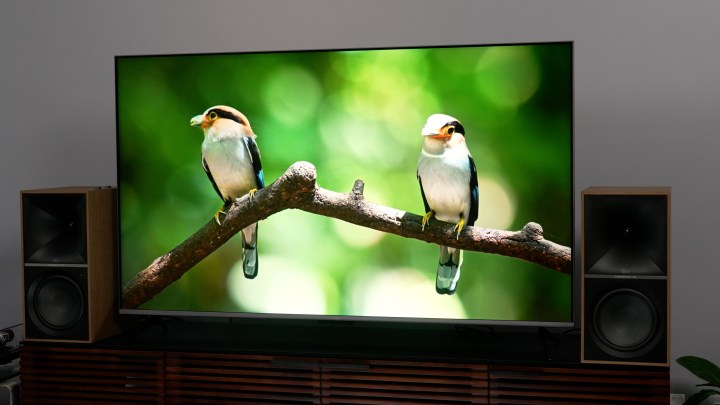
That pointed to the fact that, due to the TV’s local dimming system and how it reacted to these test patterns, it was capable of higher brightness when more backlights were being used. That is what triggered me to adjust the local dimming setting down to medium. And when I did that, peak brightness increased across the board. Now, I was getting 930 nits peak from a 25% window and closer to 850 from a 10% window. Interesting. Let’s come back to that in a moment.
White balance
Even with the warm color temperature option associated with the “movie” picture preset, the Roku Plus Series’ white was heavy on blue at the brightest setting, and in HDR, the TV tracked high on the Electro-Optical Transfer Function (EOTF) curve, so it was basically over-brightening everything by just a bit. This was true regardless of the local dimming settings changes with which I was toying around. Getting two-point white balance calibrated wasn’t too hard, but it was a bit of a bear doing a 12-point adjustment. Tis was mostly because you have to use the
Color
In short, the Roku Plus Series’ color performance wasn’t bad by any means, but color errors were well within the threshold of human perception. For example, a Delta E of 3 is just barely visible to a trained eye; the
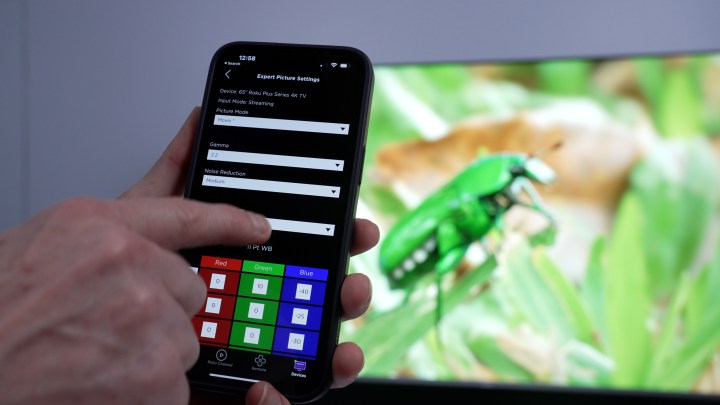
Except, that’s where the comparison piece comes in. And before I get to the comparison piece, let me just say now and echo later that, on balance, this TV looks pretty good. There’s nothing about it that has me worried someone will buy it and be upset about what they get. I think it offers solid, just above middle-of-the-road performance overall, with a couple of shining moments tossed in that will make you grin. But, again, we have to compare to see how it stacks up to other TVs you can buy.
How does it stack up?
So, what can we compare this TV with? Well, as I mentioned before, not much in the way of 2023 TVs. We have to go back to 2022 TVs, and I’d say that would bring in the Hisense U7H and probably the TCL 5-Series. Both of those TVs sell for less than the Roku Plus Series at full price, and both are still available for purchase. The TCL 5-series doesn’t get as bright in HDR as the
I’m not thrilled about the off-angle performance.
As I watched this TV, I just felt like it lacked depth and pop. I could see that the highlights were bright and punchy and colors had a lot of zest to them, but the contrast was missing. That’s because the black levels weren’t as deep as they needed to be in the picture areas. The letterbox bars on the top and bottom of the screen were nice and black, and there was almost zero blooming with normal content and minimal blooming when I turned on closed captions, but on the picture, it just didn’t have the contrast of either the U7H or TCL 5-Series. I switched the local dimming feature from high to medium, and while the average picture level and bright highlights got a bit more punchy, the contrast didn’t improve with the setting on high the way I had hoped it would.
And bear in mind, this was all evaluated as viewed directly in front of the TV. As soon as you view from off to the side a bit, or even if you’re too high or too low, the contrast and color saturation take a big, big hit. Most midrange LCD TVs do this, but the Roku Plus series seems to struggle a bit more. I’ll need to do a head-to-head comparison because perhaps my memory isn’t serving me well. I just know I’m not thrilled about the off-angle performance.
And then there’s motion. Sure, much of the content I’m watching is delivered at 60Hz from streaming services. Some of it is 24 frames per second, though. And while judder was never a big problem, motion blur is. Yes, there are some motion-smoothing options available, but I can’t stand that look. Without smoothing, I feel like the motion performance is not as good as on the TCL 5-Series or Hisense U7H. I’m going to spend some time playing some games at 60Hz and see how that goes, and I’ll update this review after I have formed some solid impressions.
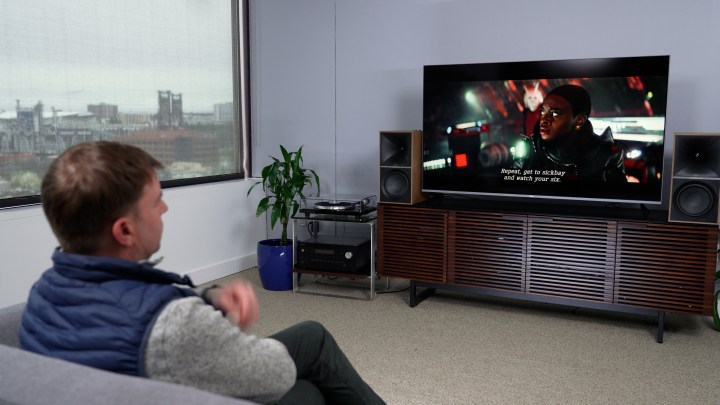
Finally – upscaling. Well, if you’re mostly streaming, I suppose the TV won’t have to do a ton of upscaling. A lot of really popular content is in 4K as it is. But, where live streaming TV is concerned, a lot of that is in 720P, and if you’re watching classic TV, that’s going to be 480p at best, and more likely, even lower resolution.
So, I loaded up the Roku channel to an episode of Two Broke Girls. It looks good, as I’d expect –a bout the same as if I was watching cable. Some stutter there, I notice. What about Quantum Leap? Certainly a trip down memory lane. This was filmed in 16:9, so it’s not zoomed in on, but the resolution is still pretty low, and there’s a fair bit of grain. Not a whole lot of cleanup processing happening here, though I will say that the TV is doing a pretty decent job getting rid of some of the banding I’d expect to see. Now, let’s go to The Rockford Files. This is in its native 4:3 format and, honestly, it looks way better than I expected. Maybe it’s because there’s less of the screen taken up by the grainy image, but for an older show, this looks solid.
I was tempted to move on to ChiPs, AirWolf, and A-Team, but that nostalgia trip will have to wait. I’d seen enough to know that the upscaling on this TV is going to be just fine for this TV’s target audience. I don’t recall either the TCL 5-Series or U7H being much better. In fact, this TV might even be a bit better than the U7H.
Other things I like about this TV? The screen uniformity is surprisingly good. There was minimal vignetting in the corners — a little bit of darkening on the left and right edges. Overall, though, it’s far better than I’ve seen on most TVs in this price bracket.
And then there’s the sound quality. Folks, I’m pretty impressed. I won’t say it is doing anything magical for dialogue clarity, but the overall fidelity is respectable. It sounds full and rich, there’s far more bass than I was expecting, and the stereo effects were truly impressive. I did not see that coming.
The verdict
So, what’s my takeaway on the Roku Plus Series TV? It’s a quality television, with some glimmers of greatness. I think it is going to stand up well against similarly priced competing Samsung, LG, and maybe even Sony TVs in terms of performance for the price. It’s TCL and Hisense,
I have to say that, for a first effort, I’m impressed. Roku could have gotten a lot wrong with this TV, but it drew on its experience blueprinting TVs for other brands and landed on really solid footing with its first upscale TV tier. How well it will end up standing up to its toughest challengers remains to be seen, but while that question is one that I think enthusiasts may be interested to see answered, most folks just looking for a really solid TV at a nice price will probably be happy to open their wallets for the
Editors' Recommendations
- What is Google TV? Here’s everything you need to know
- YouTube TV just got even better on iPhones and iPads
- What is Paramount Plus? Price, plans, and what you can watch
- Sharp’s promised Roku OLED TV is now available and deeply discounted
- Amazon is giving you 6 months of MGM+ when you buy a new Fire TV










